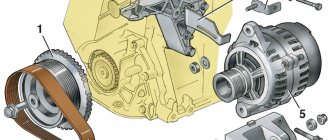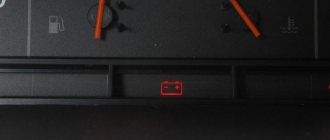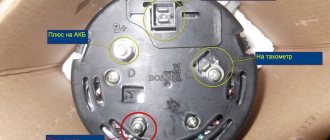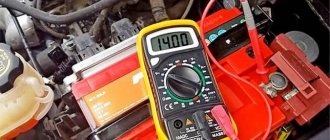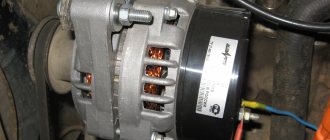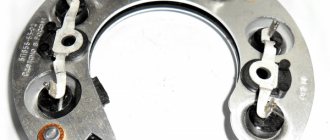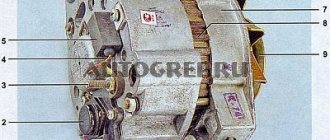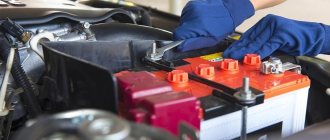Constant undercharging of the battery or its absolute discharge at the most inopportune moment is a headache for many car owners. One source of these problems may be the generator. But how to check it? Perhaps it's not his fault at all? Let's figure out together how much the generator must produce for the normal functioning of all car systems and maintaining the battery in a charged state.
How to check the operation of the generator
The battery in a car is an important element of the system, which is responsible for providing the car’s on-board network with electricity. The generator is used to charge the battery while it is active. Unstable operation of a device generating electricity causes a voltage drop in the network and failure to restore the capacity of the power source.
Normal generator performance means timely and complete replenishment of the battery charge level, which decreases under load. Checking the battery charge level from the generator is simple and can be done by the car owner himself.
Diagnostics of an automotive energy-generating device includes a visual inspection of the unit, its elements and related parts, as well as voltage and current measurements. At least twice a year, you should check the tension of the drive belt, excessive weakening of which leads to a decrease in the performance of the generator, and sometimes can lead to breakdown of the device. Once a year, you can check equipment elements - fasteners, diode bridge, voltage regulator and others. Timely maintenance of the battery will also guarantee the absence of problems - cleaning the terminals, adding distilled water.
Diagnostics of indicators such as voltage, current, resistance are also necessary twice a year. To carry it out, you will need special devices - a voltmeter, multimeter or load fork.
How to check the car battery charge using the indicator
Currently, many batteries are equipped with a built-in indicator indicating its current condition. Japan was the first to use it in battery production.
There is a special window on the battery cover. This is the car battery charge indicator. It is also called a hydrometer. Usually has a green color , indicating that it is completely infected. As the discharge progresses, the color changes. If the color is white or gray, this is a signal that part of the capacity has been lost. This means it needs to be charged. If the color is black , this means that it is completely discharged and needs to be replaced .
The principle of its operation is as follows:
- As the charge level of a car battery increases, the density of the electrolyte increases. Which in turn leads to the fact that the float, in the form of a green ball, rises through the tube and becomes visible in a special window. The float floats up when the battery charge is 66% or higher.
- If the float does not float up, then the condition of the car battery is below normal. As noted, the window will be black, but some have another red ball that will pop up when the battery charge is low.
- If the electrolyte level in the battery is low (partial loss of capacity), the electrolyte itself will be visible through the eye. In such a situation, it is necessary to add distilled water and recharge it.
How to check a battery when buying it in a store or by hand? You can also determine the health of a car battery using the indicator - a fairly simple and easy way .
However, it is worth remembering that the indicator makes it possible to make a preliminary assessment of the degree of charge, but not an accurate one. And you should not fully rely on his testimony; there are more accurate methods. In addition, such a check is not possible with all batteries; some are not equipped with this window. Therefore, it is important to be aware of other methods.
What kind of charging should go to the battery from the generator?
It is traditionally believed that 13.5-14.5V should be supplied by the generator to the battery and this is absolutely enough to replenish the battery costs.
It is worth considering that using a battery with a higher power in a car than the manufacturer recommends also requires the installation of a more productive generating device.
It is necessary to take into account the load that the generator must withstand - it is calculated based on the maximum indicators of all electrical appliances and car systems.
Do not forget that the charging current from the energy-generating device will allow you to start the car in the cold season. In order to avoid problems with starting the car, we recommend purchasing generating equipment, the charge current of which will be approximately 10% of the capacity of the power source. That is, a battery of 100 A/h requires a generator that can produce 10A. Please note that for many cars, 100 amp equipment will operate at its maximum capacity, because the power consumption of the automotive system is in the region of 80 amps. Therefore, the choice of a source generating energy must take into account both the battery capacity and network consumption.
How to check the alternator voltage on the battery
The potential difference can be diagnosed in two ways - directly at the generating equipment and through the battery. The generator is directly connected to the power source with a thick wire, therefore, to check the level of potential difference, you can measure the voltage at the power source. To do this, you will need special devices - a voltmeter, multimeter or load plug.
The wires of the first measuring instruments are connected to the battery in any sequence. The plug must be connected to the battery terminals with strict observance of polarity. It is generally accepted that the normal voltage in the network should not be lower than 12 volts. At idle speed without turning on all the electrical appliances of the car, this indicator should be at the level of 13.5-14V. A drop in voltage values to 13.3-13.8 volts is considered acceptable.
At the same time, using conventional testing equipment, you can check the resistance of the generator elements - rotor, stator and diode bridge. Diagnostics of rotary equipment is carried out by its winding. It is necessary to connect the probes of the device with slip rings. If the multimeter gives readings from 2, 3 to 5.1 ohms, then this element is working. The current consumption of the winding should be within 3-4.5 amperes.
Its normal resistance is 0.2 Ohm. The diode bridge is checked by the presence or absence of resistance, the indicators do not matter. The only thing worth considering is that there should not be a zero dimension. Measurements are carried out in pairs - positive output and all plates on this side or minus and all elements.
We remind you that for normal charging of a car battery, the voltage supplied by the generator must be from 13.5 to 14 volts.
How to test a 12-volt generator removed from a car at home
At home, a generator removed from the engine can be checked by “ringing” the circuit of elements in series with an ohmmeter. Using this method, you can determine the condition of the windings, diode bridge and relays.
The voltage is measured by securely securing the generator in a vice and connecting the adapter head from the drill to the center nut of the drive. Turn on the drill and use a voltmeter to measure the voltage at the terminals. If the indicators, depending on the speed, are in the range of 12.2 - 14.8 Volts, then the generator is working.
How many amperes does a car alternator produce per battery?
The current strength required by the electrical system of each car is individual and depends on the number of electricity consumers and their values. And also the charge current must be sufficient to charge the power source.
It is worth noting that ampere readings appear only when there is a load in the vehicle’s electrical system and, accordingly, the battery is discharged. After starting the car engine, the charging current is about 6-10 amperes and drops over time, because the battery is charging, taking on the main energy consumption. If you turn on additional equipment - headlights, radio or heated mirrors, you can see an increase in the charging current values.
When purchasing a generator, pay attention to its technical characteristics, which the manufacturer indicates on the case - that’s where you will find information about the maximum current that will flow to the battery.
In the table below you can see the approximate current values that the generator shows at different loads.
Table 1. How many amperes the generator produces under load.
Reasons for the battery not charging
Now we know how to check the charging on a car, the next step is to find the fault. The main reasons for lack of charging:
- Poor contact of battery terminals;
- Broken generator belt;
- Battery charging fuse blown;
- Failed battery;
- Broken wiring or short circuit;
- A broken car generator.
Poor terminal contact and broken generator belt. First of all, you need to open the hood of the car and check the condition of the alternator belt and terminals . The belt should be in tension and not loose. Pay attention to its condition, if it is a rivulet, then are all the rivulets intact? The battery terminals must be screwed in place; no oxide (white or light green deposits) around them is allowed. You should also check the integrity of the contact of the power wires with the terminals themselves, usually these are the places where they are bent. Wires don’t like this very much and it happens that they simply break off from the terminals.
Blown battery charging fuse . Not all cars have it, of course, but there are some. A car most often has two safety blocks, each should be checked: one under the hood, the other under the steering column. Their location depends on the car brand. You should open the cover of the fuse block; on its back side the fuse numbers and their purpose are indicated. If you find a fuse responsible for charging in the car, you should check its integrity.
Defective battery. This reason is the easiest to determine. Because if the reason is in the battery, then you will have charging, but the car will not “want” to start again after stopping the engine. Usually the battery fails due to lack of proper care or deep discharge. You can try to revive such a battery by fully charging and checking the density of the electrolyte, unless, of course, the banks in it are short-circuited.
Charging the battery
Broken wiring or short circuit. A wiring break can occur due to poor wire insulation or chafing. At the contact points, the wiring is very weak and often oxidizes, and after some time a break occurs. This is most often observed in cars over 20 years old. First of all, check the integrity of the wiring at the generator terminals.
A broken wire is often accompanied by a short circuit . As a rule, in places of short circuit there are always melted wires and a burning smell . You will find such a reason without much difficulty, but eliminating the consequences of this disaster can already be problematic. Usually, during a short circuit, all the car’s instruments go out and it shows no signs of life. If you find a short circuit, you should immediately turn off the power to the car by removing the battery terminal. Do this carefully. In the event of a short circuit, the car terminals heat up and you can get burned .
How to determine the lack of battery charging due to a break? Check the voltage at the generator with the engine running. This should be done between the car body and the power wire on the generator (thick, most often red wire). If the voltage there does not correspond to the required one, do not rush to get upset, the next step will be to check the supply of excitation voltage to the generator .
To do this, you should remove the small chip from the generator. There are usually two wires connected to it: one is the power wire through which the charging current flows, the other is the generator excitation wire, which goes to the control lamp on the dashboard. So, the polarity on the small wire should change when the ignition is turned on. To check the voltage on the excitation wire you will need an assistant. If the polarity on the excitation wire does not change , look for a wire break . Of course, this is a rare case, but it does happen.
Failed generator. This problem is the most common. the voltage regulator or brush assembly fails . Usually all this is combined in a so-called “ tablet ”, to which there is open access. Changing it is not difficult, and it is not that expensive. First, you should remove the brush assembly to assess its condition . This can most often be done without removing the generator ; before starting work, be sure to remove the negative terminal of the battery. If the brushes are worn out, then of course there will be no charging. The next thing to do is check the voltage regulator . The easiest way to find a diagram specifically for your generator is on the Internet and use it to check the condition of the regulator with a multimeter.
Voltage regulator
If the problem is not in the tablet, then you will have to remove the generator from the car and disassemble it .
Signs of a generator malfunction
In modern cars, breakdowns of the electrical system are one of the most common. A large number of electronics requires particularly careful monitoring of the operation and condition of the generator and battery, because their failure can immobilize the car. The most common signs of a generator malfunction are:
- battery indicator light on the instrument panel;
- unstable operation of the battery (its boiling over or undercharging);
- different intensity of headlights;
- extraneous sounds from the generator.
If you notice incorrect operation of the car, then perhaps the battery charging current from the generator is insufficient.
All malfunctions of electrical equipment, which includes the vehicle’s energy-generating device, are mechanical (deformation or breakage of fasteners, housing, malfunction of bearings, pressure springs, drive belt, etc.) or electrical (winding breaks, diode bridge malfunctions, burnout or wear of brushes , short circuits between turns, breakdowns, etc.).
Don’t write off a non-working generator: find out if there are repair kits and spare parts. Replace them if possible. If you cannot carry out repair work yourself, then take the generator to a workshop. Many craftsmen will be able to restore the unit at no extra cost and in the shortest possible time.
However, some breakdowns require the purchase of a new device that generates electricity. For example, a failing bearing that is soldered into the generator housing cannot be restored or replaced in most cases.
Remember that failure of this unit can be caused not only by wear and corrosion, but also by poor quality of elements and components; excessive load; external influence of salts, liquids, temperatures.
